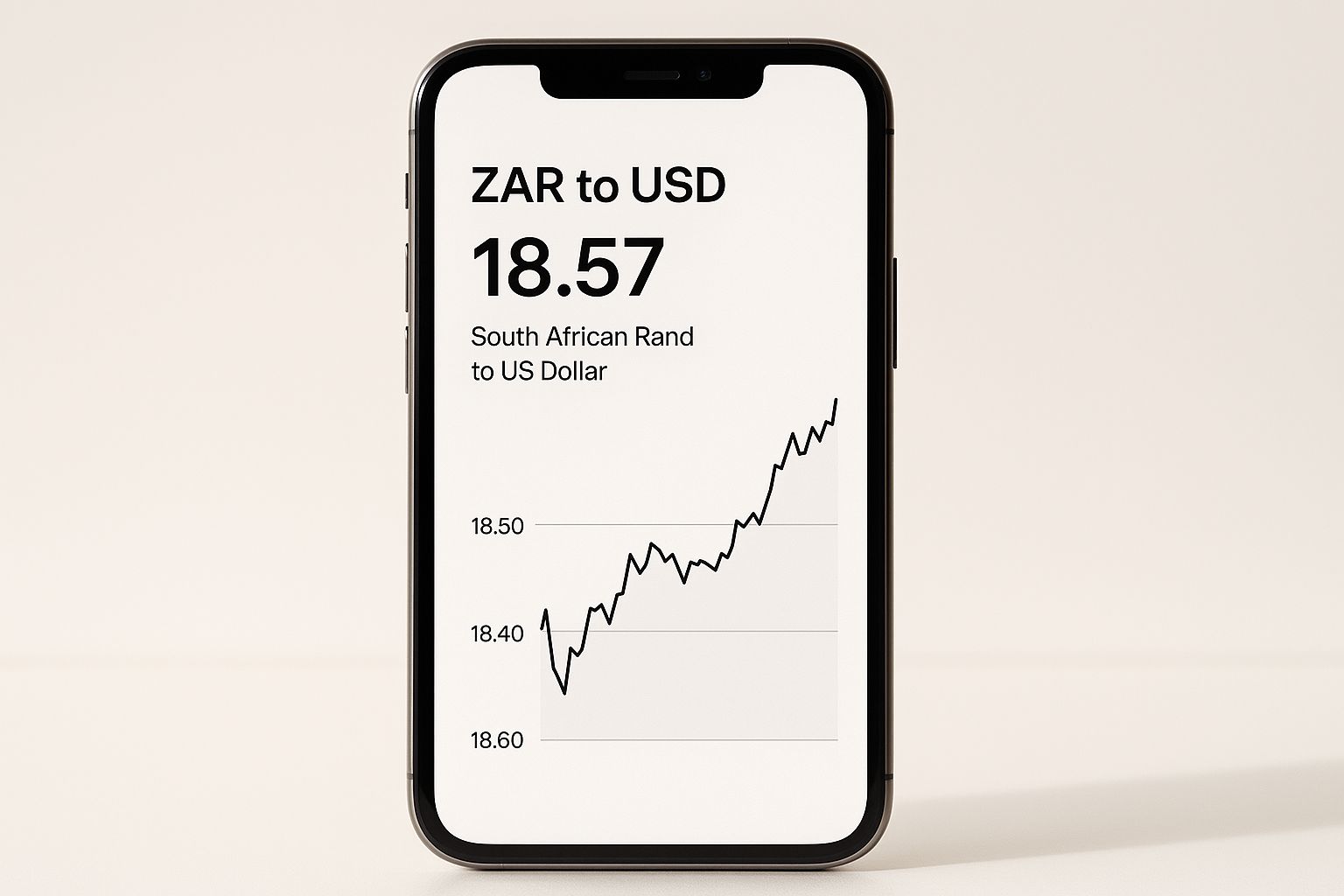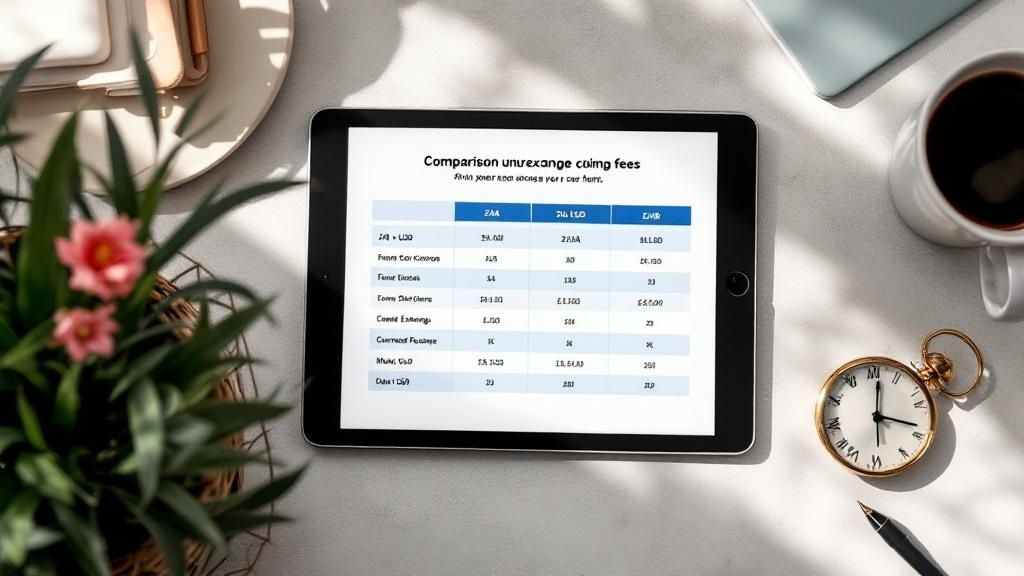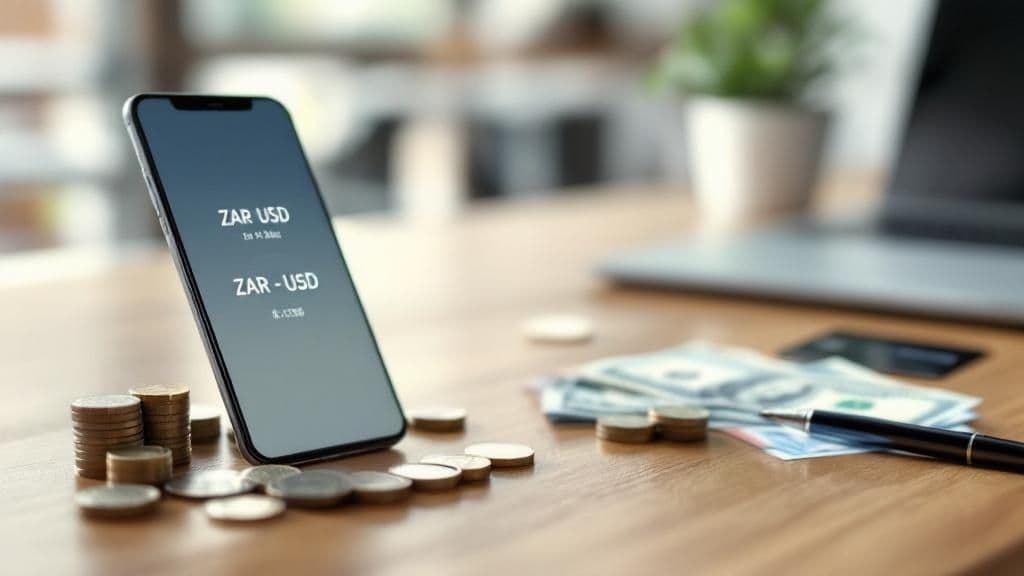When you're looking to send money from South Africa to the US, the first thing you probably do is check the ZAR to USD rate on Google. But that number, while a good starting point, is rarely the rate you'll actually get. To really know how many dollars you’ll end up with, you have to dig a little deeper and understand the real exchange rate—the one a service offers after factoring in all its fees and hidden costs.
What Really Moves the ZAR to USD Exchange Rate?
Before you even think about making a transfer, it’s helpful to get a feel for what makes the ZAR/USD rate tick. It’s not just random numbers changing on a screen. Think of it more like a tug-of-war, with powerful economic forces pulling the rate in different directions every single day.
The South African Rand has a reputation for being 'volatile'. This just means its value can jump up or down pretty quickly, sometimes in a matter of hours. A few key things are usually behind these swings:
- The Health of South Africa's Economy: Things like local interest rates set by the Reserve Bank, inflation figures, political news, and economic growth reports all influence how confident international markets are in the Rand.
- What the World is Paying for Commodities: South Africa is a huge exporter of natural resources like gold, platinum, and coal. When the global prices for these commodities go up, the Rand often gets a boost along with them.
- Global Investor Mood: This is a big one. When global markets get jittery, investors tend to pull their money out of what they see as riskier currencies (like the Rand) and move it into 'safe havens' like the US dollar. This can weaken the Rand pretty fast.
The "Google Rate" vs. The Rate You Actually Get
Here’s where a lot of people get caught out. You see a great rate on a search engine, but when you go to your bank, the number they show you is different—and not in your favour.
That rate you see on Google is the mid-market rate. It's the midpoint between what buyers are willing to pay and what sellers are asking for a currency on the global markets. It's the purest, most real-time rate out there, but it's almost never the rate offered to regular customers.
The gap between the mid-market rate and the rate a bank or forex service gives you is called the 'spread'. This spread is basically their profit margin, a hidden fee baked right into the exchange rate. A bigger spread means you get fewer dollars for your rands.
Let's say the mid-market rate is R18.50 to $1. Your bank might offer you a rate of R18.90. That R0.40 difference is their spread. It doesn't sound like much, but if you're sending thousands of rands, it can add up to a significant chunk of your money simply vanishing.
Why Looking at Past Rates Matters
Keeping an eye on historical trends can give you a much better sense of whether the current rate is a good deal or not. Over the last five years, the ZAR to USD exchange rate has been on a bit of a rollercoaster, reacting to everything from local politics to global market shifts.
For example, as of 12 April 2025, the mid-market rate was around 1,000 ZAR to 52.25 USD, which works out to about 1 ZAR = 0.05225 USD. This rate is part of a broader trend we’ve seen since 7 July 2020, where the Rand has generally been on the weaker side against the dollar. If you're curious, you can dive into more of this historical currency data on Wise.com. Knowing these patterns helps you spot a genuinely favourable window to make your transfer.
Comparing Your Currency Conversion Choices
When you need to send Rands to the US, you've got a few options. The real trick, though, is figuring out which one won’t secretly chip away at your money with bad rates and hidden fees. Let's walk through the main players: the old-school banks, dedicated forex services, and the newer online platforms.
Each route has its own mix of speed, cost, and convenience. What’s perfect for sending a small birthday gift to a cousin in New York could be a terrible choice for paying a large supplier invoice. Knowing the difference is the first step to making a smarter currency exchange.
The Big Three Conversion Methods
You're essentially looking at three camps. First, there are the traditional high-street banks like FNB or Standard Bank, offering a familiar, if sometimes slow, process. Then you have specialist forex bureaus—think of places like Travelex you see in airports and shopping centres, which exist solely to exchange currency.
And finally, you have the digital-first online money transfer platforms. Services like Wise, Payoneer, and our own platform, Zaro, have completely shaken up the old way of doing things, often by being more upfront about costs and offering better rates.
The real number to watch isn't the advertised fee. It's the total cost of your transaction. This is a combination of the exchange rate markup (the 'spread') and any fixed fees, which together decide how many actual US dollars land in the recipient's account.
To make this crystal clear, let's look at how these options stack up side-by-side.
Comparing ZAR to USD Conversion Methods
The table below gives you a quick overview of what to expect from each type of service when converting your Rands into Dollars. It’s a good starting point for figuring out which path aligns best with your priorities, whether that's cost, speed, or in-person service.
| Method | Typical Exchange Rate | Average Fees | Transfer Speed | Best For |
|---|---|---|---|---|
| Traditional Banks | Mid-market rate + 2-5% markup | High (R400-R800 SWIFT fees) | 2-5 business days | Large, infrequent transfers where familiarity is preferred over cost. |
| Forex Bureaus | Mid-market rate + 3-7% markup | Can be commission-based or have high fixed fees | Instant (for cash) | Last-minute, small cash exchanges, like for travel money. |
| Online Platforms | Mid-market rate + 0.5-2% markup | Low, transparent fees (often a small fixed fee + percentage) | A few hours to 2 business days | Almost everyone—from freelancers and small businesses to individuals. |
As you can see, the differences, especially in the exchange rate and fees, can be significant. This is where your money is either saved or lost.
A Real-World Cost Comparison
Let’s put some real numbers to this. Imagine you need to send R100,000 to a business partner in the United States. Today, the real mid-market exchange rate is, let's say, R18.50 to the dollar.
Here's how that R100,000 might look after it passes through different hands:
- A Major Bank: Might give you a rate of R18.95 and slap on a R500 SWIFT fee. Your R100,000 becomes $5,250.66.
- A Forex Bureau: Their rate might be a touch better at R18.85, but they charge a hefty R700 commission. Your R100,000 now gets you $5,267.90.
- An Online Platform (like Zaro): We use the real R18.50 mid-market rate with no markup. With just a small, fixed fee (for instance, R250), your R100,000 converts to $5,391.89.
In this scenario, just by choosing the online platform, you’d have saved over $140 compared to the bank. If you’re a business making these kinds of payments regularly, those savings add up fast and can make a genuine difference to your bottom line.

This just shows how much the live rate can change in a short time. Locking in a good rate is crucial, as even tiny shifts, when combined with provider markups, can have a very real impact on your money.
So, How Do You Choose?
The right method really boils down to your specific situation.
Banks offer a certain peace of mind and a face-to-face service that some people still value, even if it comes at a premium. Forex bureaus are handy for grabbing foreign cash in a hurry, but their rates are often the worst of the bunch—especially those located in airports.
For most people and businesses today, online platforms simply offer the most compelling deal. Here’s why:
- Better Exchange Rates: They stick much closer to the mid-market rate, with little to no hidden markup.
- Lower Fees: Costs are usually transparent and fixed, not based on confusing percentages.
- Faster Transfers: Payments are often completed in a matter of hours, not days.
- Total Convenience: You can handle everything from your desk or phone, from setup to tracking the payment.
Before you make any transfer, the smartest thing you can do is get a quote from at least two different types of providers. A quick comparison of the all-in cost is the single best way to ensure you aren't needlessly losing money. You’ll be surprised how much you can save.
A Better Way: Using Modern Platforms for Seamless Currency Exchange
If you've ever dealt with international payments, you know the frustration of using traditional banks. Online money transfer platforms have completely turned this old model on its head. They consistently offer far better exchange rates and significantly lower fees, which means more money stays right where it belongs—in your pocket.
Switching to a modern, digital-first service to convert ZAR to USD might seem like a leap, but the process is refreshingly simple and secure.
These platforms are designed for one thing: efficiency. To get started, you'll create an account using your business details and go through a quick identity verification. This is a standard security step, often called Know Your Business (KYB), that keeps both you and the platform safe while ensuring everyone complies with financial regulations.
Once you’re set up, you can start tapping into the real advantages. Let's imagine you need to pay a US-based supplier. You'd link your South African business bank account—a straightforward, one-time task. From then on, you can top up your new digital wallet with Rands whenever you have a payment to make.
How a Transfer Actually Works
When you're ready to send the money, you just need to decide how much to send. You can either specify the ZAR amount you want to convert or the exact USD amount you need your recipient to get. The platform will instantly show you the live exchange rate—often the real mid-market rate you'd see on Google—and a small, transparent transfer fee. No more hidden SWIFT charges or nasty surprises.
After you've double-checked the details, you lock in the rate. This is a fantastic feature because it shields you from any unfavourable market swings while your transfer is being processed. Then, you just add your recipient's US bank details, hit send, and you’re done. Most platforms even let you track your money from start to finish, so you know exactly when it leaves your account and when it arrives.
The biggest win here is transparency. You see the final, guaranteed amount the recipient will get before you commit. This takes all the guesswork and anxiety out of the equation—a feeling anyone who has used an old-school bank for an international transfer knows all too well.
For a clearer picture, take a look at what a modern currency converter looks like. This example shows the live rate and fees with total clarity.

Notice how it clearly breaks down the mid-market rate, the platform’s fee, and the final converted amount. It's a level of honesty that’s often missing from bank quotes.
Tools Built for Business
These services go far beyond simple one-off transfers. Many platforms, including our own at Zaro, offer powerful tools designed specifically for business operations. For instance, you can get multi-currency accounts that let you hold balances in both ZAR and USD. This is a game-changer for managing international revenue and expenses without constantly losing money on conversions.
You'll also find other incredibly useful features:
- Rate Alerts: Not happy with today's rate? Set a target ZAR to USD rate, and the platform will ping you the moment the market reaches it.
- Batch Payments: If you need to pay multiple international suppliers or freelancers, you can do it all at once with a single upload. Think of the admin time you'll save.
- Team Access: You can grant specific permissions to your finance team, giving them access to manage payments while you maintain overall control.
By embracing these digital tools, South African businesses can take a much more strategic approach to currency exchange. It’s not just about saving money; it’s about making your entire operation faster and more efficient.
Of course, here is the rewritten section with a more natural, human-written tone:
Using Banks and Forex Bureaus: The Traditional Route
For some, there's a certain comfort in walking into a familiar bank branch or a forex bureau. Maybe you need to exchange physical cash, or perhaps you just prefer handling important transactions face-to-face. While newer online platforms often give you more bang for your buck, these traditional institutions are still a go-to for many, so it’s worth knowing how they work when you need to convert ZAR to USD.
Just be prepared for a bit more paperwork. The process is noticeably more manual than what you’ll find online. This isn't just your bank being difficult; they're following strict exchange control regulations set by the South African Reserve Bank, which apply to every single cross-border payment.
Getting Your Documents in Order
Before you head out, you'll need to get a few things together. You can't just show up and ask for dollars. Make sure you have a valid form of identification – your green bar-coded ID book or a smart ID card will do the trick. You’ll also need to prove where you live with something recent, like a utility bill or bank statement that’s less than three months old. This is all standard procedure to verify who you are and comply with anti-money laundering laws.
Once you’re at the counter, your first move is to ask for a quote. Pay close attention here. The rate they show you won't be the "real" rate you see on the news. It will have their profit margin, or "spread," built-in.
Here's a pro tip: Always ask, "What is the final amount in USD I will receive after all fees?" This one question cuts through the confusing jargon and shows you the true cost, making it much easier to compare with other options.
Unpacking the True Cost of Your Transfer
This is where traditional services can get pricey. The exchange rate is just one part of the puzzle. You’ll often find a collection of other fees that eat into your final amount.
Be on the lookout for:
- Commission Fees: Usually a percentage of the amount you're sending.
- Admin Fees: A flat charge just for handling the transaction.
- SWIFT Fees: A fee for using the global banking network to send your money internationally, which can be surprisingly high.
These charges stack up. A R500 admin fee plus a 2% commission can take a significant bite out of your funds before the currency is even exchanged.
Time is another factor. If you're swapping cash, it’s instant. But if you’re sending an electronic transfer through your bank, it can easily take two to five business days for the money to land in the US account. That delay could be a real problem if you're up against a tight deadline.
There’s no denying the security and long-standing reputation that comes with using a bank. But you have to weigh that against the higher costs and slower service. Always take the quote from the bank or bureau and compare it against a live online service. A few minutes of due diligence can make a real difference, ensuring your Rands stretch as far as possible when you turn them into Dollars.
Actionable Tips for a Better Exchange Rate

Timing your transaction and choosing the right service can make a staggering difference to how much money actually lands in your account. Securing a better exchange rate isn't about luck; it's about being strategic. With a few smart moves, you can maximise the dollars you receive for your rands.
A little patience often pays off. The ZAR/USD rate is notoriously volatile, meaning it can swing quite a bit even in a single day. Instead of converting on the exact day you need the funds, try to start watching the rate a week or two beforehand. This gives you a much better feel for the rhythm of the market and what a "good" rate actually looks like.
Be Smart About Timing and Tools
Many modern currency platforms offer brilliant tools to help you time your exchange perfectly. Here’s what I recommend:
- Set up rate alerts: You can tell the service what exchange rate you’re hoping for. The moment the market hits that number, you'll get a notification. This lets you pounce on favourable movements without being glued to the charts all day.
- Look beyond the rate: A tempting exchange rate can easily hide hefty fees, and a low fee can mask a poor rate. Always, always compare the total cost of the transfer. This means the exchange rate plus every single admin charge, commission, or hidden fee. It’s the only way to know who’s really giving you the best deal.
When you get a quote, cut through the noise by asking this simple question: “If I give you R10,000 right now, exactly how many US dollars will land in the recipient's account after all fees are deducted?” This forces total transparency and makes comparing different services dead simple.
Avoid Common Money Traps
One of the biggest mistakes people make is exchanging large sums of money at airport forex kiosks. They're convenient for last-minute travel cash, for sure, but their rates are usually among the worst you’ll find. They’re banking on that convenience, and you pay a very high price for it.
Another powerful tip is to use a service that offers a guaranteed rate. When you lock in a rate, you’re shielded from market swings while your transfer is being processed. The rate you see is the rate you get. No surprises. This completely removes the anxiety that the market might dip while your funds are in transit—a very real possibility with the rand.
The ZAR is sensitive to all sorts of economic news, causing its value to shift frequently. For example, historical data from the Federal Reserve shows that on one day, the spot rate was 17.8113. You can dig into these historical exchange rates yourself on the FRED database.
By applying these simple, practical strategies, you can take control of your currency exchange and ensure you’re not leaving money on the table when you convert ZAR to USD.
Got Questions About ZAR to USD Conversions? We've Got Answers
Diving into currency exchange often brings up a few questions, no matter how many times you’ve done it. Whether you're running a business or sending money to family, getting clear answers is what matters. Here’s a look at some of the most common queries we hear about converting ZAR to USD.
What's the "Best" Time to Convert My Rands?
Everyone wants to nail the timing and get the best rate. The truth is, there's no crystal ball for predicting currency movements. The Rand is notoriously volatile, meaning the rate you see one day can be a distant memory the next.
For example, look at what happened in April 2025. The USD/ZAR rate rocketed to a high of 19.93, a significant dip for the Rand. Some analysts predicted it would eventually stabilise around 18.20 by the middle of the year, while others saw it hovering closer to 18.73 within 12 months. This shows just how much things can swing. You can dive deeper into these trends and historical data on platforms like Trading Economics.
My advice? Don't try to time the market perfectly. Instead, use a service that gives you a transparent rate and low fees so you know you're getting a fair deal, regardless of the day.
Is It Cheaper to Convert in South Africa or the US?
This is a great question, and my answer is almost always the same: it's better to sort out the conversion from South Africa.
Trying to convert Rands once you’re in the US—if your bank even allows it—usually ends with you getting a terrible exchange rate and paying steep fees. When you use a South African-based specialist for international payments, you tap into much better rates and keep control over the entire transaction right from the start.
Are There Limits on How Much I Can Send?
Yes, absolutely. South Africa has exchange control regulations that you need to be aware of. People often ask, "How much money can I actually send out of the country?"
For individuals, you have two main allowances. There's the Single Discretionary Allowance (SDA), which lets you send up to R1 million abroad per calendar year without needing tax clearance. For larger amounts, you can use the Foreign Investment Allowance (FIA), which goes up to R10 million, but this comes with more paperwork.
What Documents Do I Need for a Large Transfer?
If you're sending a sum that falls under the Foreign Investment Allowance, you'll need more than just your ID book. The most important document is a Tax Clearance Certificate (TCC), which you get from the South African Revenue Service (SARS).
This certificate proves your tax affairs are up to date. Banks and currency platforms are required by law to ask for it before they can process any transfer over your R1 million discretionary limit. To avoid any frustrating delays, it's a good idea to get your TCC sorted out well in advance.
Ready to experience a smarter, more transparent way to handle your international payments? With Zaro, you get the real exchange rate with zero spread and no hidden fees. Sign up today and see how much your business can save.
